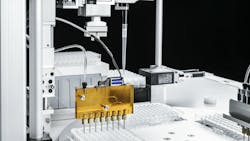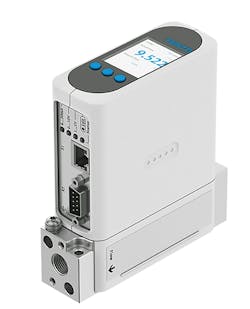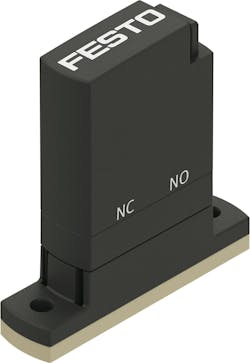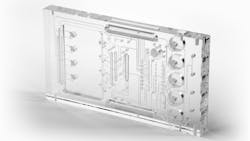Festo Brings Automation Expertise to Life Sciences Industry
Automation is increasing in a wide range of industries, including life sciences. Laboratory testing, pharmaceutical production and other applications in this sector are employing more automation to improve productivity and costs.
To aid these efforts, Festo Corp. is applying its pneumatic and electric automation expertise to the development of technologies designed specifically to meet the requirements of the life sciences industry.
Read "Automation Uptake in Life Sciences Brings Market Opportunities" to learn more about why automation is increasing in the life sciences industry and the growth opportunities Festo sees in this sector.
Offerings for this sector can range from single components to full system solutions and everything in between. Joshua Lamontagne, Product Market Manager, LifeTech, at Festo said that within the company’s life sciences portfolio (branded LifeTech) there are three main areas of product development:
- Liquid handling – media separated liquid valves, as well as dispensing and pipetting solutions.
- Motion – an extension of Festo’s electric automation solutions featuring gripping, capping and de-capping, and handling technology.
- Gas Control – an extension of traditional pneumatic technology which controls gases.
In recent years, Festo has added several new products to its LifeTech portfolio including a rotary gripper capable of using electric or pneumatic gripper technology as well as a mass flow controller and media separated valves.
Compact Gripper Technology Standardizes Decapping Processes
Festo developed its EHMD Rotary Gripper to help minimize the reliance on manual processes still utilized in many laboratory settings. The gripper can grip and rotate small objects infinitely, enabling it to be used as part of handling and assembly technology for the opening and closing (i.e., decapping and recapping) of vials, test tubes, and containers.
According to Lamontagne, if a laboratory is looking to automate its decapping processes, it will often create its own decapper by combining an off-the-shelf gripper and rotary table. “However, this means there is not going to be a lot of consistency,” he said.
“One lab might have a different solution than another, and also the solution that they make for one specific vial may not necessarily work with another one,” he explained. “It's not able to fit across many applications.”
The EHMD solves this problem by being dynamic, enabling control for different vials and torques which allows a single gripper technology to be used across many different applications. “That's why [the gripper] was developed, to try to standardize this capping and decapping process across the industry,” said Lamontagne.
Through its ability to repeatedly execute simple, standardized movements, the gripper provides assurance the capping and decapping process is the same every time, a necessity in the life sciences industry where consistency is critical to quality and safety.
The gripper can be used in tandem with various other Festo automation components such as electrical axes, valves and more. Lamontagne said the gripper is controlled by standard Festo motor controllers, enabling seamless integration with other products from the company.
“This allows you to increase throughput by coordinating motion and not having individual modules that you then have to control at a higher level,” he said. “These can be controlled at the PLC (programmable logic controller) level or at the motor controller level to work together.”
Lamontagne said the EHMD gripper is very compact, which is critical in laboratory spaces where benchtop space is at a premium. Its compact size can benefit other applications as well such as special machine building applications or small part assembly like that required in the electronics industry.
“What we're able to offer with Festo life sciences [products] is space savings,” he said. “These products were designed with laboratory automation in mind, where we have as small of a space as possible to do the same amount of work. [And now these] products are able to save space on larger production lines and time savings through easy installation because everything works together in the Festo ecosystem.”
Choosing Between Electric and Pneumatic Actuation
The EHMD utilizes electric actuation but can be equipped with an electric or pneumatic gripper. Lamontagne said the choice between an electric or pneumatic gripper is application dependent. If a customer already has pneumatic air supply in their system, the pneumatic gripper is going to be the more cost-effective option.
However, he noted that a lot of laboratories do not have a pneumatic air supply. “Providing that for a single solution isn't cost effective, so they're going to go with [an electric option],” he said. “We’re seeing that electric actuation in these labs is the default technology.”
Although not related to the EHMD gripper technology, he said the company is seeing more use of pneumatic actuation in analytical devices. “You’re able to fit more actuation in a smaller space with pneumatics,” he explained. “So, we’re seeing some of our customers developing standalone tabletop pneumatic air supplies for a single application.”
For those applications, Lamontagne said Festo will work with customers to size out the pump, air preparation and other necessary technologies since they will be trying to fit a pneumatic system into a very small space.
While he said electric actuation tends to be the default technology for many laboratories, “as customers want to miniaturize, they're moving more towards pneumatics because you're able to miniaturize more effectively with pneumatics. But that has its own problems as well.”
Watch Festo's video below to see how its EHMD gripper can be used for different processes in a laboratory application.
New Fluidic Control Solutions Bring Space and Cost Savings to Life Sciences Applications
In the area of fluidic control — which applies to both air and liquid — Festo has developed a new mass flow controller, the VEMD, as well as a pair of media separated valves to meet the space and cost savings required in many life sciences applications.
VEMD Mass Flow Controller
Lamontagne said gas control in laboratories tends to be a manual process. “This is done with manual regulators and needle valves, where a technician will come in and turn a needle valve to match the flow that's required for that day,” he explained. “This requires a lot of input from technicians, and it doesn't provide any feedback.”
In addition, it is not a scalable or reproducible process. As these laboratories want to scale in size, he said they're looking to automate a lot of processes including gas control which led Festo to develop the VEMD mass flow controller.
It provides closed-loop feedback in gas control applications, specifically for laboratory settings said Lamontagne. While mass flow controllers have existed in the market for a long time, he said what the VEMD aims to provide is an option offering both space and cost savings for laboratory automation. “We're trying to strike a balance between the cost of a mass flow controller and the accuracy that's required.”
The flow controller is comprised of:
- integrated flow sensor
- closed-loop control electronics
- proportional flow control valve.
The controller’s valve will open or close based on a set point users put into the system explained Lamontagne. For example, if the set point is 100, then the valve opening will increase until that set point is achieved.
Multiple types of gases can be controlled using the same mass flow controller; users simply need to change the gas set point in the control electronics. Flow ranges from 10-200 l/min are possible with an accuracy of ±2% of the value.
For this mass flow controller, he said Festo leaned on technology it has developed on the pneumatic side of the business. “We have a lot of closed loop pressure controllers on our pneumatic side that use the same technology,” he said. “The only difference is, rather than controlling to a flow, our more traditional controllers will control to a pressure. So, we're really leaning on and expanding our pneumatics portfolio with this mass flow controller.”
Lamontagne noted that while Festo’s industrial pneumatic mass flow controllers are designed to hit one or two set points and just stay there repeatedly, Life Science mass flow controller offers more dynamic flow control. “We have much better dynamic range depending on what the customer's [gas] chemistry is; they're able to change that day over day,” he said. “Our [VEMD] mass flow controller can hit that more reliably than industrial mass flow controllers.”
Read "Pneumatics in the Lab" to learn more about the use of pneumatics in laboratory applications.
VYKA and VYKC Media Separated Valves
Festo has developed two media separated valves, the VYKA and VYKC, for the life sciences industry which were designed with liquid flow in mind said Lamontagne.
“What you see in laboratory settings is there's often limited sample size or an expensive reagent and you're worried about using enough to get the results that you want,” he explained. “But you're also worried about contamination, either from your previous sample or from the internal components of the valve.”
The VYKA and VYKC are solenoid valves with a spring and a magnetic plunger. A laboratory does not want its samples or reagent touching these internal components because they are very sensitive to leaching and contamination.
To prevent contamination issues, Festo designed its media separated valves to have a very small internal volume. In addition, the internal components are separated from the media that goes through the valve by an internal elastomer diaphragm. “By separating these components, you're no longer worried about contamination,” said Lamontagne. “And by having a small internal volume, you're able to flush out the valves much easier and have less cross contamination from one sample to the next.”
He went on to say the VYKA valve also offers the benefit of being compact in size. “For the given flow rate of this valve, we have the smallest footprint on the market,” he said. “You’re able to flow more liquid in a smaller footprint.”
Typically, as the flow rate of a valve increases so too does its footprint. The VYKA valve overcomes this though by enabling the miniaturization desired in many space-constrained laboratory settings while also providing higher throughput in the same space.
The VYKC valve is compact compared to others in the marketplace as well, though larger in size than the VYKA which enables it to be a lower-cost option for those customers where price is a determining factor.
With these media separated valves “we can really meet whatever the customer needs, whether they need a compact, high-performance valve or a similar flow rate but lower cost valve,” said Lamontagne.
Another benefit he noted is that the VYKA valve offers the life sciences sector is its tight leak rate. “Our VYKA valves are about 100 times more leak tight than a standard pneumatic valve,” he said which suits use in both gas and liquid applications and help meets the high standards required in this industry to ensure accuracy and safety.
To accompany the valves it offers the life sciences industry, Festo has also developed valve manifolds. These can include single channel options as well as multi-channel versions.
Lamontagne explained that in a space-constrained application, it may be necessary to use a single valve to dispense liquid through eight channels in a manifold. To ensure control of the liquid is maintained as it moves through the manifold, Festo creates curved channels which get smaller as they approach the dispensing needle at the bottom of the manifold.
Because there is no easy way to easily machine a single manifold with this type of design, he said the company developed a method in which it machines two halves of the manifold and then bonds them together into a single device. “This allows us to create more complex manifolds, as well as manifolds that save more space.”
To further aid space savings in life sciences applications, Festo has developed a fitting as well. “This fitting seals on the surface, so there's no dead space from the threading as you would have with a typical pneumatic fitting,” said Lamontagne. “This isn't new technology in the market…but we wanted to develop this within Festo so that we could have a full complement of products to save space for customers.”
About the Author
Sara Jensen
Executive Editor, Power & Motion
Sara Jensen is executive editor of Power & Motion, directing expanded coverage into the modern fluid power space, as well as mechatronic and smart technologies. She has over 15 years of publishing experience. Prior to Power & Motion she spent 11 years with a trade publication for engineers of heavy-duty equipment, the last 3 of which were as the editor and brand lead. Over the course of her time in the B2B industry, Sara has gained an extensive knowledge of various heavy-duty equipment industries — including construction, agriculture, mining and on-road trucks —along with the systems and market trends which impact them such as fluid power and electronic motion control technologies.
You can follow Sara and Power & Motion via the following social media handles:
X (formerly Twitter): @TechnlgyEditor and @PowerMotionTech
LinkedIn: @SaraJensen and @Power&Motion
Facebook: @PowerMotionTech

Leaders relevant to this article:





